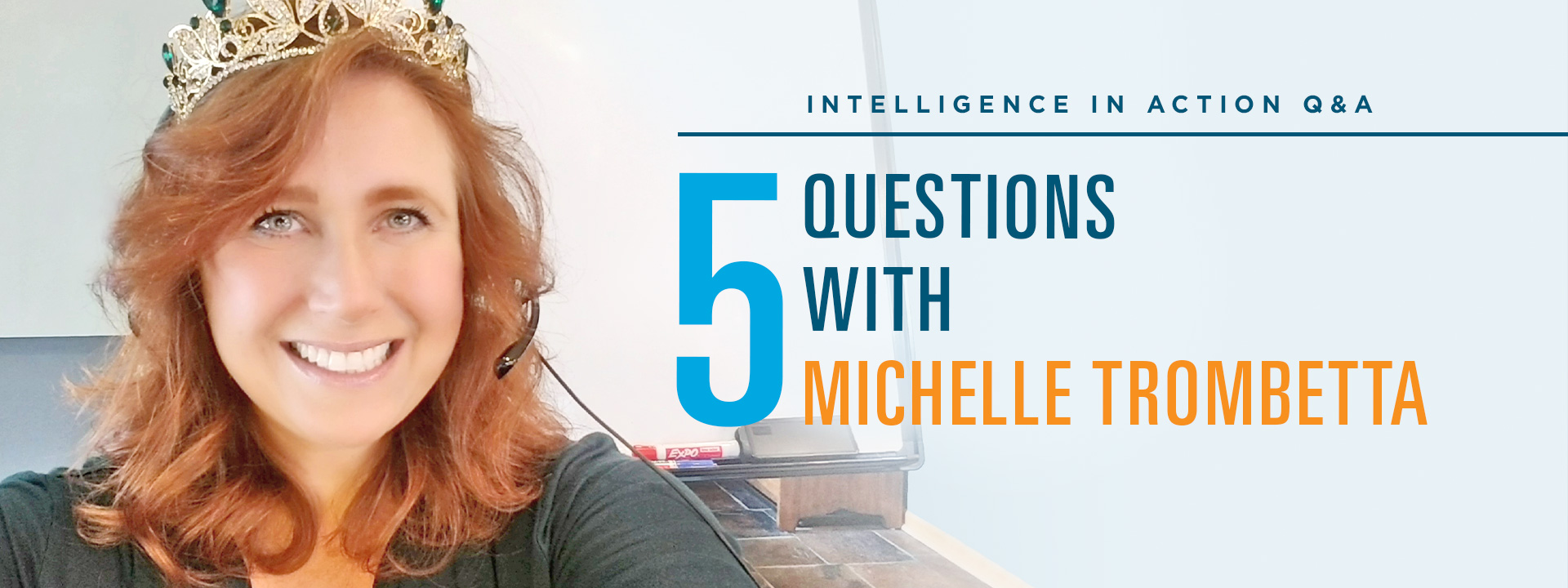While Michelle Trombetta has held many different titles in product, technology, and operations, and had the opportunity to work across the globe, one thing has been consistent, and that’s her desire to make a positive impact on the world around her. Even when that world is virtual. Like many of us, Michelle and her team are all working from home these days, separated from the usual energizing bustle of the office. To keep things lively (and perhaps lift some spirits), Michelle started the ‘Fancy Friday’ movement. (See photo above.) It’s the opposite of casual Friday, and a way for people across Surescripts to end another week at home with some fun and flair. Or maybe she’s just looking for an excuse to show off her impressive collection of fascinators and crowns!
As Surescripts Director of Product Innovation, Michelle plays an active role in developing tools that improve the patient experience, like Real-Time Prescription Benefit. “Price transparency is an incredibly important way to address the mounting healthcare costs in this country,” she says. Others agree: the Centers for Medicare & Medicaid Services are requiring Medicare Part D plans to integrate at least one Real Time Benefit Tool by January 1, 2021.
As we honor the people who impact patient experience every day during Patient Experience Week, I sat down with Michelle to learn more about the important role of price transparency at the point of care.
1. When you chat with colleagues, what topics, trends or advances are you talking about lately?
The biggest thing we’re talking about right now is getting more prescribers to embrace Real-Time Prescription Benefit as a tool that can measurably improve the care experience—for prescribers and patients alike.
Prescribers are just so very busy. They may see a patient for eight or nine minutes, and in that time they have so many things to do. Adding a price conversation into the mix can seem overwhelming or awkward, but prescription price transparency isn’t noise; it’s not something that will add to provider burnout. Quite the opposite, in fact.
Our technology lets prescribers see a patient’s out-of-pocket cost and coverage information, including clinically appropriate therapeutic alternatives that may save the patient money, all within their EHR. They can literally turn their screen around and have a conversation with the patient to choose the best, most affordable medication. And using this tool can reduce rework for the prescribers and support staff, including all the back-and-forth phone calls between the pharmacist, prescriber, and patient if a drug ends up being too costly or if a prior authorization isn’t approved. Best of all? The patient leaves the office knowing how much their prescription is going to cost when they arrive at the pharmacy—with no surprises at the counter. They can pick it up and get on with their busy day.
2. How would you talk about price transparency at a cocktail party (or virtual happy hour, now that we’re social distancing)?
I’ve found that offering a real-life example is most effective, one that even the healthiest person would be able to relate to. I happen to be asthmatic, but it is really well controlled and I only refill my inhaler every two years. When I refilled it last year, it came to $210, quite a bit more than the $15 copay from years ago. I paused before accepting the prescription, thinking surely there had to be something less expensive. My doctor never mentioned the cost, and my pharmacy didn’t have a timely way to check alternatives. I experienced real sticker shock, and admittedly, was a little embarrassed to ask if there were any less expensive inhalers available. This is the exact experience we’re trying to eliminate with prescription price transparency at the point of care. We want patients to have a positive experience and be informed consumers who pick up their prescriptions with confidence.
3. Who do you consider influencers, innovators or leaders?
I consume leadership books like they’re my lifeline. I’ve been very fortunate in that I’ve had years of experience managing people, but humans are complex! It’s inevitable that something comes up you’ve never experienced before and need to lean into others who have. As we are all navigating what a pandemic means to our families, our friends, our careers, and our communities, I’ve been talking to other leaders and reading about the balance between vulnerability and keeping a brave face. There’s real power in vulnerability, especially with COVID-19. Through reading Brené Brown and Simon Sinek I’ve learned to have enough vulnerability to admit to the people across our company and beyond that as a lung-compromised extroverted hugger, social distancing, working from home, and watching the news isn’t easy for me. I hope being open about my own COVID-19-related anxieties and struggles extends grace and understanding to those who might need it.
4. Who or what inspires you?
My niece, who has a rare genetic disorder, inspires me. I keep a photo of her on my desk to remind me why what we do at Surescripts is so important. I’m honored to wake up every day and do work that positively impacts the lives of little girls like her who are on lots of medications, as well as the lives of their parents and caregivers.
5. It’s 2030. What are you most proud of having helped accomplish in healthcare?
Whether it’s now or a decade from now, I take great pride in cultivating tomorrow’s leaders through managing, coaching, mentoring and volunteering. In fact, one of my goals in life is to report to someone who used to report to me! My own mark of success is seeing the people I’ve worked with become strong, capable, driven and compassionate leaders who put patient experience and outcomes at the center of their decision making.
To get more familiar with price transparency and the patient experience, check out our recent price transparency data brief. Fascinator not required.


 Dean Riggott Photography
Surescripts
Dean Riggott Photography
Surescripts





